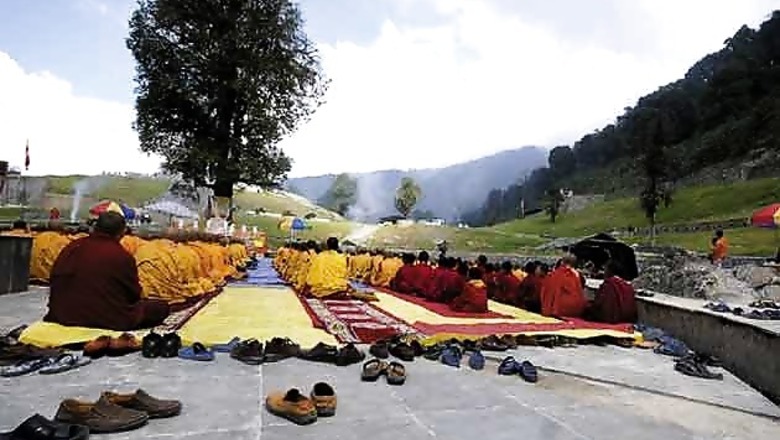
views
Arindam is an RI, a Returning Indian, as the new acronym goes in migrationspeak. His Facebook page informs his friends that he's "pinged 105 cities across the world". So when our car crosses Melli, on the Bengal-Sikkim border, his voice is a stubble of sounds: "Imagine, I've never been to Sikkim!"
I like that exclamation mark and provoke it with promises of the unseen. We are headed to Namchi—at a height of 4400ft, the name appropriately means 'Sky' (nam)-'High' (chi)—and I try to entertain Arindam with stories as we climb skywards. I tell him about the spirit of poisoner-princess Pende Ongmoo, who is said to haunt the town and, when he shows no interest, perhaps because of motion sickness, I switch to a story about Sikkim's most famous son, footballer Baichung Bhutia, after whom the stadium in the town is named. Next come stories about the Buddhist monks who climb the Samdruptse to offer it prayers to calm it down: It's a dormant volcano, such go the whispers.
When stories of football and fear fail, I reveal the real reason for my visit to the town: I want to see how Namchi is gradually being turned into a pilgrimage town. The atheist in him sits up. Perhaps it is easier to see God in Becoming than in Being.
When we reach Namchi, it is evening. We go to the local parade ground where a mela is underway. Pretty girls dance in prettier bakus, young men sing Nepali songs, some play the guitar imitating the style of their favourite American artistes, different tribes showcase their culture through their cuisine and a display of their traditional living quarters, and everywhere, everyone eats and drinks their favourite local food and local wine.
Local: That word reverberates everywhere, turning everything exotic. The fair—a feature I notice all across the North-East—is organised by self-help groups to show the world who they are. It’s a clever concept, blurring the boundaries between the home and the world, highlighting the difference that will arouse the curiosity of the tourist. Call it the craft of living in the age of tourism.
Arindam and I carry back two things from the mela: One, the belief that a renewed, even reinforced, self-pride—a badge of ethnicity often used in protest movements—has become the symbol of commerce; and two, something akin to a nervous delight, like the energy of a bride moments before her wedding. Namchi’s destiny, it seems, would be to trade in religion, just as its neighbours, Pelling and Yuksom, deal in nature.
Next morning, I awake to a cling-clang sound. At first I think it’s the buzz of my sleep. Then I realise my brother, now posted as a banker in Namchi, in an unbecoming continuation of his childhood, is making himself a cup of Horlicks, the metal spoon beating the lump of powder into smoothness.
Outside, there are similar sounds. I wonder whether this is part of a morning ritual in Namchi, one of the many things introduced to morph this near-forgotten town into a pilgrimage centre: Maybe everyone makes and drinks their morning health cuppa at the same time.
"Is there a temple nearby?" I ask.
"No."
"Then where is the sound of chanting coming from?"
"It's the garbage woman," he says.
"The garbage-collector chants?" I am flummoxed.
"Yes," he says, "don't you hear the cling-clang metal sound asking the town's residents to come out with their garbage bags?"
I'm surprised. Could this be possible?
The smell of incense sticks wafts through the air. A neighbour has dedicated his morning to the invisible.
Suddenly, my brother begins to laugh. I run to the balcony to see what amuses my serious-natured sibling. There's no one on the road. In the tiny, pretty children's park that this apartment watches over, there's not a stir, only rows of red poinsettias that construct the geometry of childhood in structures like these all over the country.
And then I hit him on the head.
It was a joke.
How could I have believed him? How could I have really believed that a garbage-collector would chant the announcement of her arrival to the world?
There is something about the 'atmosphere' in the 'hills', as plains-living India would say, that infuses an air of the sacred—or, at least, seemingly sacred—into almost everything: the chill of the air, the length of the day, the freshness of vegetable skins, the way nature continues to create, construct and rule the lives of those who live here, out of choice or compulsion.
As I sit writing in my brother's apartment, the woman's chant continues at the same pace. Later, during the many times I see hill-dwellers walk up or down the mountains, looking at them from the back, from the car, where there is never a uniform pace, I feel that the unhurried temper of the chant is nearly the same as the rhythm of the hills and its life. Nothing is slow or fast. Even the curtains flutter at the tempo of the clap that musicians call som.
But these could not have been a part of the Sikkim chief minister's grand scheme of turning an ordinary hill town into a site of pilgrimage.
Every festival season, my brother carries news of the Indian prime minister’s impending trip to Namchi. Deferred visits and planned welcomes have given birth to local jokes: Pawan Chamling might succeed in getting an appointment with God for Namchi, but one with Manmohan Singh looks unlikely.



















Comments
0 comment